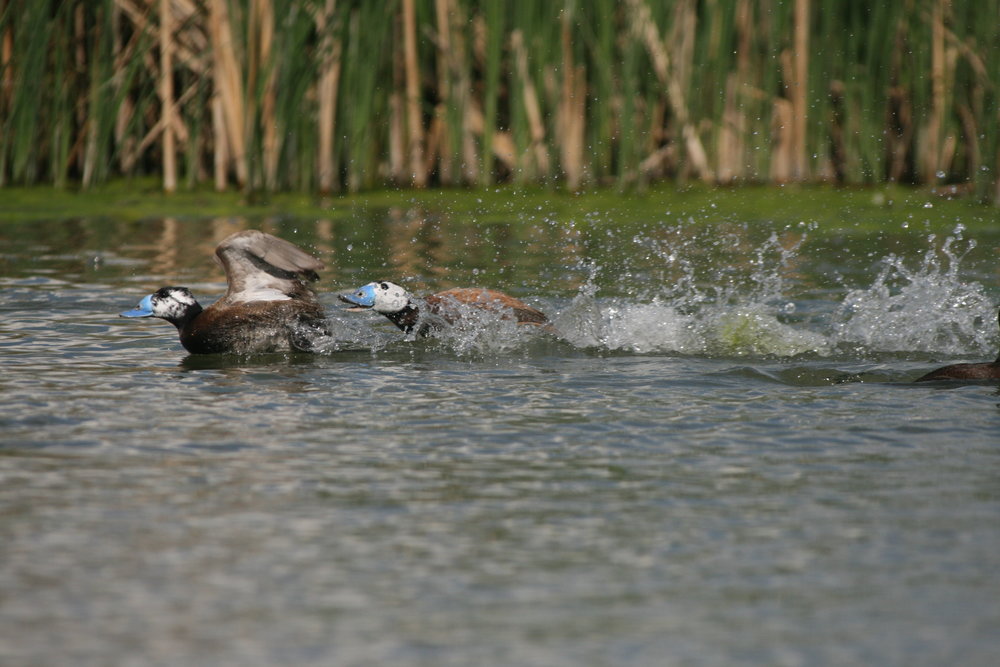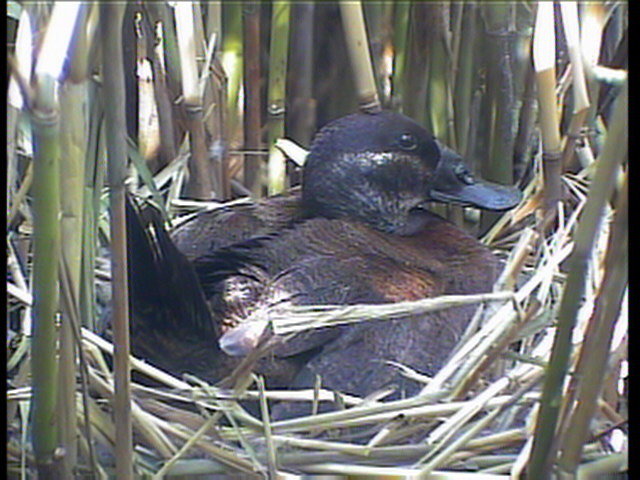White-headed ducks fall into drastic decline

Long-term population declines for the white-headed duck have recently intensified in Iran as a result of habitat loss at the key sites such as Fars Province, Sistan Province, Lake Gurigöl and also south of Lake Urmia.
Distinguish from other diving ducks
Male white-headed ducks are unmistakable with white head, large blue bill and long stiff tail often held cocked. Females have dark brown head and variable grey and dark striped cheek pattern. Their bills are grey and swollen at base. Their juveniles are duller and paler than females, and in flight looks elongated with short uniform wings appearing far forward on body. They live in reedy, shallow lakes, and brackish lagoons.
Conservation Status and distribution
International Union for Conservation of Nature and Natural Resources (IUCN) categorized white- headed duck as an Endangered (EN) in 2016. It also confirmed this species as resident in Spain, Algeria and Tunisia. A larger population breeds primarily in Russia and Kazakhstan, and also Turkey, Iran, Afghanistan, Tajikistan, Turkmenistan, Uzbekistan, Armenia, and Mongolia (believed to be increasing in the latter). Its status in China is unclear, but it appears to be rare. It occurs on passage/in winter in the eastern Mediterranean, the Middle East, and central and south Asia.
History of decline
The white-headed duck probably had a global population of over 100,000 in the early 20th century; in the 1930s an estimated 50,000 wintered on the Caspian Sea. However, by 1991 the population was estimated at a mere 19,000 ducks. This reduction in numbers was matched by a large decline in breeding range.
Over the last 100 years the white-headed duck has become extinct as a breeding bird in Albania, Azerbaijan, Corsica, Hungary, Italy, Morocco, and former Yugoslavia. Despite the historical declines, however, there was some optimism in 1991, since the population was thought to be relatively stable.
Since 1991 that optimism has faded. Numbers appear to have plummeted over the last decade to fewer than 10,000 birds. The decline has been most severe at what was the most important wintering site, Burdur Gölü in Turkey. In 1991 about 10,900 birds wintered there, but in 1996 only 1,270 were recorded.
Obviously, some of the birds have simply scattered to other wetlands, and wintering numbers have increased elsewhere in the eastern Mediterranean region. They include the doubling of the population at Lake Vistonis, Greece, with other larger increases in Bulgaria and Romania. However, the counts do not compensate for the very large declines at Burdur Gölü.

Reasons for the decline
The large historical declines are mostly the result of extensive drainage of wetlands, particularly in the former Soviet Union, Spain and Iran. Over 50 percent of breeding habitat was destroyed during the 20th century, and the remaining sites are especially vulnerable to eutrophication (over-enrichment by nutrients, particularly nitrates and phosphates) and pollution. The range of threats include industrial, domestic, and agricultural pollution, sedimentation, and water extraction, as seen at Burdur Gölü and the Sultan marshes in central southern Turkey. At Lake Vistonis drowning in fishing nets is a severe threat. Dead birds have also been found in nets at sites in Spain and Turkey.
Major threats in Iran
The main threat for white-headed ducks is illegal trade and habitat loss. Fereydunkenar bazar considered as a main source of illegal trade of wild birds such as white-headed duck especially in winters. While a major problem for the white-headed duck is habitat loss, many populations are also threatened by human conflicts. There are also problems such as hybridization and competition with the North American ruddy duck for western European populations but in Iran there is absolutely no confirmed data in this field. In fact, hybrid samples of ruddy duck and white headed ducks are limited to Europe region not Asia at all. As we know, some measures are being taken to control the ruddy ducks in France, Portugal, Spain, and Netherlands. But the story of white-headed ducks in Iran refers to unsafe life.

Great effort in Spain
The Spanish control program is one element of a highly effective conservation strategy that was started in 1979. Since then a reduction in illegal hunting, the regeneration of natural vegetation, the release of captive-bred birds into the wild, and from 1989 shooting of ruddy ducks and hybrids has led to a dramatic population recovery.
Andalucía Bird Society websites said: “White- headed Duck like eutrophic conditions and that these occur at Rambla Morales when there is a lot of treated waste water being pumped there from the nearby village. This occurs in summer, for example, when there are more people staying on the coast and therefore more waste water. In contrast, after heavy rain, the water in The Pool is ‘cleaner’ and there is less chance of seeing the species. Meanwhile, Almería province played a significant role in the reproductive success of White-headed Duck in the 1990s. Now, although its global status remains a matter of concern, the Spanish population of the species exceeds 4,500; a ‘good news’ story. White-headed Duck, and many other species - can these days almost always easily be seen floating in and out of the reeds that fringe the charco at the Rambla Morales, as well as at locations to the west of Almería city such as the Salinas de Cerrillos and the Cañada de las Norias.”
But the challenge is to replicate the success of the Spanish program for more easterly populations. The effective protection of wetlands in Russia and Kazakhstan and also Iran is a high priority. Without such protection it is almost certain that the white- headed duck will continue its dramatic decline.
Leave a Comment